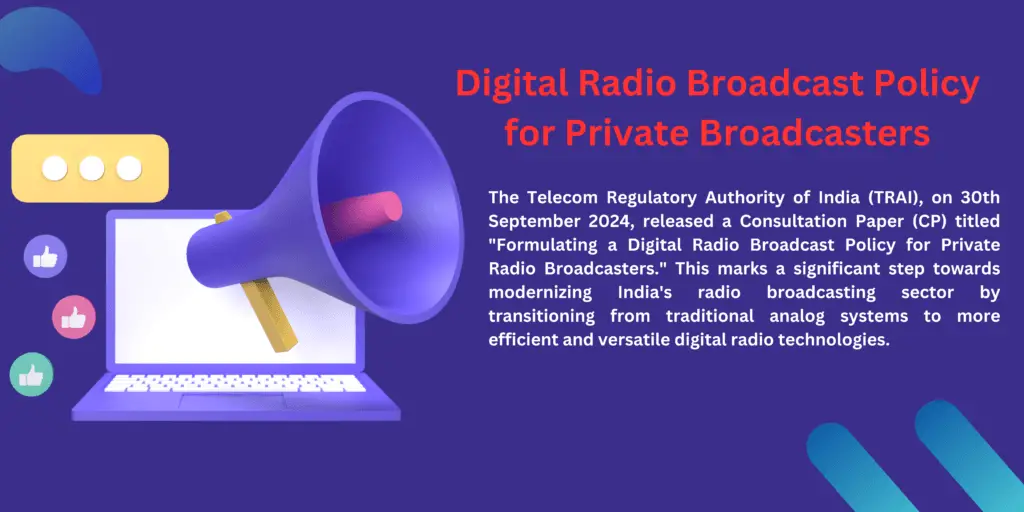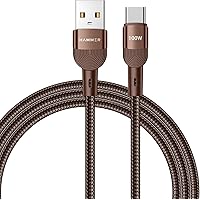
The future of Radio in India : A shift towards Digital Broadcasting
The Telecom Regulatory Authority of India (TRAI), on 30th September 2024, released a Consultation Paper (CP) titled “Formulating a Digital Radio Broadcast Policy for Private Radio Broadcasters.” This marks a significant step towards modernizing India’s radio broadcasting sector by transitioning from traditional analog systems to more efficient and versatile digital radio technologies.
Radio has been an integral part of India’s communication landscape for decades, providing an affordable and accessible medium for information, entertainment, and news. However, the landscape of broadcasting is rapidly evolving, driven by the need for technological advancements. As the digital age progresses, analog radio systems, which have been the backbone of the industry for years, are beginning to show their limitations in terms of spectrum efficiency and audio quality. In response, India is looking to make a major shift toward digital radio broadcasting, marking the beginning of a new era for radio in the country.
Why Digital Radio?
Radio remains one of the most accessible and affordable forms of mass communication in India, reaching millions of people across diverse regions. Despite technological advancements, radio broadcasting in India is still largely analog. As of now, All India Radio (AIR) provides analog broadcasts on Medium Wave (MW), Short Wave (SW), and Frequency Modulation (FM) bands, but private FM broadcasters have yet to explore digital radio.
Digital radio broadcasting offers several advantages, including:
- Efficient Spectrum Use: Digital transmission allows multiple channels on a single frequency, unlike analog, which is limited to one channel per frequency.
- Superior Audio Quality: It delivers clearer sound with fewer interruptions and interferences.
- Value-Added Services: Digital broadcasting enables the integration of features like emergency alerts, program guides, and weather updates.
The consultation paper highlights that despite the potential, the private sector has not yet taken substantial steps toward adopting digital technologies in FM broadcasting. AIR has begun trials for digital radio, and in a phased rollout, they are replacing analog MW and SW transmitters with digital ones.
Current status of Radio Broadcasting in India
According to the TRAI consultation paper, India is still heavily reliant on analog radio transmissions, mainly through the FM (VHF-II band 88–108 MHz) spectrum. All India Radio (AIR) is the largest public broadcaster, offering services in Medium Wave (MW), Short Wave (SW), and FM bands. However, private broadcasters only operate within the FM band.
Efforts to digitize India’s radio system began with AIR, which has already started digitizing its MW and SW networks using DRM (Digital Radio Mondiale) technology. Yet, the private sector is lagging behind, as no substantial steps have been taken by private broadcasters to adopt digital systems(consultant paper).
All India Radio (AIR), India’s public service broadcaster, provides radio services on all three bands (MW, SW, and FM), while private broadcasters are limited to the FM band. The current analog system is effective but highly limited in spectrum efficiency and sound quality, allowing just one channel per frequency.
International scenario of Radio Broadcasting
Countries around the world have adopted various digital radio standards. For example:
- DAB/DAB+: Used in the UK, Germany, and Australia.
- HD Radio: Predominantly used in North America.
- DRM: Implemented in countries like India (AIR), Germany, and South Africa.
Each system offers different benefits, and the policy must weigh which would be best suited for India, considering both technological and market factors.
Key issues in formulating the Digital Radio Broadcast Policy
The consultation paper seeks input on several critical questions, including:
- Choice of Technology: Should India adopt a single digital radio technology, or should multiple technologies be allowed, giving broadcasters flexibility? TRAI suggests that HD Radio and DRM+ could be suitable candidates for India’s FM radio landscape.
- Roadmap for Implementation: How should the transition from analog to digital be managed? The paper proposes a phased approach, starting with major cities and gradually expanding, allowing broadcasters to continue analog services while transitioning.
- Affordability of Digital Receivers: The success of digital radio depends largely on the availability of affordable digital receivers. The consultation asks for suggestions on how to ensure that digital radios are accessible to the masses.
AIR’s move towards digitalization
All India Radio (AIR) has already begun the transition to digital by upgrading its Medium Wave (MW) and Short Wave (SW) networks with digital transmitters. As of now, AIR has replaced 38 analog transmitters with digital ones, and trials for digital radio technology in the FM band have also been conducted. However, private FM radio broadcasters have yet to make significant strides in adopting digital technologies.
TRAI’s 2018 recommendations and the need for a policy framework
In 2018, TRAI had suo-motu issued recommendations titled “Issues related to Digital Radio Broadcasting in India.” In these recommendations, TRAI highlighted the urgent need for collaboration among key stakeholders—broadcasters, transmission equipment manufacturers, and digital radio receiver manufacturers—to develop a robust ecosystem for digital radio broadcasting. The 2018 TRAI recommendations also emphasized the importance of the government developing a comprehensive policy framework that outlines a clear roadmap for rolling out digital radio broadcasting services(Consultation paper).
The Ministry of Information and Broadcasting (MIB), via its letter dated 23rd April 2024, requested TRAI’s recommendations on creating a digital radio broadcast policy specifically for private broadcasters. This request reflects the MIB’s understanding that existing regulations, particularly those under the FM Phase-III policy, may need to be revisited to accommodate the impending technological shift.
Key issues highlighted in the consultation paper
TRAI’s consultation paper raises a range of questions and issues that will need to be addressed in formulating a comprehensive Digital Radio Broadcast Policy. Some of these issues include:
- Choosing the Right Technology: The digital radio broadcasting policy must consider the most suitable technologies (e.g., Digital Radio Mondiale (DRM), HD Radio) for deployment in India.
- Infrastructure Requirements: The shift from analog to digital will require significant infrastructure upgrades, especially for private broadcasters.
- Simulcast Options: The paper explores the possibility of allowing private broadcasters to transmit both analog and digital signals simultaneously to ensure a smooth transition.
- Stakeholder Collaboration: A central theme is the need for collaboration between broadcasters, equipment manufacturers, and government bodies to create a supportive environment for digital radio.
- Fiscal Incentives: The government may need to offer incentives, such as tax reductions, to manufacturers of digital radio receivers to accelerate market adoption.
Invitation for public comments
TRAI has invited written comments from stakeholders by 28th October 2024, with counter-comments accepted until 11th November 2024. Comments can be submitted electronically via email to advbcs-2@trai.gov.in and jtadvbcs-1@trai.gov.in (Consultation paper).
Conclusion
The transition to digital radio broadcasting represents an exciting new chapter in the evolution of India’s radio industry. While All India Radio (AIR) has made significant progress in digitizing its networks, the private sector still has a long way to go. The TRAI consultation paper marks the beginning of a broader conversation on how India can effectively embrace this technological shift. With the right policy framework in place, digital radio broadcasting has the potential to revolutionize the industry, offering more content, better quality, and enhanced services to millions of listeners across the country.
This consultation process is a crucial step in ensuring that all voices—broadcasters, manufacturers, and listeners—are heard as India moves forward into the digital radio era.
निजी प्रसारकों के लिए डिजिटल रेडियो प्रसारण नीति का निर्माण: नवाचार की ओर एक कदम
भारत में रेडियो का भविष्य: डिजिटल प्रसारण की ओर एक बदलाव
भारतीय दूरसंचार विनियामक प्राधिकरण (TRAI) ने 30 सितंबर 2024 को “निजी रेडियो प्रसारकों के लिए डिजिटल रेडियो प्रसारण नीति का निर्माण” शीर्षक वाली एक परामर्श पत्र (Consultation Paper) जारी किया। यह भारत के रेडियो प्रसारण क्षेत्र को पारंपरिक एनालॉग सिस्टम से अधिक कुशल और बहुमुखी डिजिटल रेडियो प्रौद्योगिकियों की ओर स्थानांतरित करने की दिशा में एक महत्वपूर्ण कदम है।
रेडियो दशकों से भारत के संचार परिदृश्य का एक अभिन्न अंग रहा है, जो सूचना, मनोरंजन और समाचारों का सुलभ और किफायती माध्यम प्रदान करता है। हालांकि, प्रसारण का परिदृश्य तकनीकी उन्नति की आवश्यकता से प्रेरित होकर तेजी से विकसित हो रहा है। जैसे-जैसे डिजिटल युग आगे बढ़ रहा है, एनालॉग रेडियो सिस्टम, जो वर्षों से उद्योग की रीढ़ रहे हैं, स्पेक्ट्रम दक्षता और ऑडियो गुणवत्ता के संदर्भ में अपनी सीमाएँ दिखाने लगे हैं। इसके जवाब में, भारत डिजिटल रेडियो प्रसारण की ओर एक बड़ा बदलाव करने की दिशा में देख रहा है, जो देश में रेडियो के लिए एक नए युग की शुरुआत करेगा।
डिजिटल रेडियो की आवश्यकता क्यों है ?
रेडियो भारत में सबसे सुलभ और किफायती जन संचार माध्यमों में से एक है, जो विविध क्षेत्रों में लाखों लोगों तक पहुँचता है। तकनीकी प्रगति के बावजूद, भारत में रेडियो प्रसारण अभी भी बड़े पैमाने पर एनालॉग है। वर्तमान में, ऑल इंडिया रेडियो (AIR) मीडियम वेव (MW), शॉर्ट वेव (SW), और फ्रिक्वेंसी मॉड्यूलेशन (FM) बैंड पर एनालॉग प्रसारण प्रदान करता है, लेकिन निजी एफएम प्रसारकों ने अभी तक डिजिटल रेडियो का उपयोग नहीं किया है।
डिजिटल रेडियो प्रसारण कई लाभ प्रदान करता है, जिनमें शामिल हैं:
- स्पेक्ट्रम का कुशल उपयोग: एनालॉग की तुलना में, डिजिटल प्रसारण एक ही आवृत्ति पर कई चैनलों की अनुमति देता है, जबकि एनालॉग एक आवृत्ति पर केवल एक चैनल तक सीमित रहता है।
- बेहतर ऑडियो गुणवत्ता: यह कम अवरोधों और व्यवधानों के साथ स्पष्ट ध्वनि प्रदान करता है।
- मूल्य वर्धित सेवाएँ: डिजिटल प्रसारण आपातकालीन अलर्ट, प्रोग्राम गाइड और मौसम अपडेट जैसी सुविधाओं के एकीकरण को सक्षम बनाता है।
परामर्श पत्र में कहा गया है कि संभावनाओं के बावजूद, निजी क्षेत्र ने एफएम प्रसारण में डिजिटल प्रौद्योगिकियों को अपनाने की दिशा में अभी तक महत्वपूर्ण कदम नहीं उठाए हैं। AIR ने डिजिटल रेडियो के परीक्षण शुरू कर दिए हैं और चरणबद्ध तरीके से एनालॉग MW और SW ट्रांसमीटरों को डिजिटल ट्रांसमीटरों से बदल रहे हैं।
भारत में रेडियो प्रसारण की वर्तमान स्थिति
TRAI के परामर्श पत्र के अनुसार, भारत अभी भी बड़े पैमाने पर एनालॉग रेडियो प्रसारण पर निर्भर है, मुख्य रूप से FM (VHF-II बैंड 88–108 MHz) स्पेक्ट्रम के माध्यम से। ऑल इंडिया रेडियो (AIR) मीडियम वेव (MW), शॉर्ट वेव (SW), और FM बैंड में सेवाएँ प्रदान करने वाला सबसे बड़ा सार्वजनिक प्रसारक है। हालांकि, निजी प्रसारक केवल एफएम बैंड के भीतर ही कार्य करते हैं।
भारत के रेडियो सिस्टम को डिजिटाइज़ करने के प्रयास AIR के साथ शुरू हुए, जिसने DRM (डिजिटल रेडियो मॉन्डियल) प्रौद्योगिकी का उपयोग करके अपने MW और SW नेटवर्क को डिजिटाइज़ करना शुरू कर दिया है। फिर भी, निजी क्षेत्र इस मामले में पीछे है, क्योंकि अभी तक निजी प्रसारकों द्वारा डिजिटल सिस्टम अपनाने के लिए कोई ठोस कदम नहीं उठाए गए हैं।
रेडियो प्रसारण का अंतरराष्ट्रीय परिदृश्य
दुनिया भर के देशों ने विभिन्न डिजिटल रेडियो मानकों को अपनाया है। उदाहरण के लिए:
- DAB/DAB+: यूके, जर्मनी, और ऑस्ट्रेलिया में उपयोग किया जाता है।
- HD रेडियो: मुख्य रूप से उत्तरी अमेरिका में उपयोग किया जाता है।
- DRM: भारत (AIR), जर्मनी, और दक्षिण अफ्रीका जैसे देशों में लागू किया गया है।
प्रत्येक प्रणाली अलग-अलग लाभ प्रदान करती है, और नीति को यह देखना होगा कि भारत के लिए तकनीकी और बाजार कारकों को ध्यान में रखते हुए कौन सा सबसे उपयुक्त होगा।
डिजिटल रेडियो प्रसारण नीति तैयार करने में प्रमुख मुद्दे
परामर्श पत्र कई महत्वपूर्ण सवालों पर इनपुट चाहता है, जिनमें शामिल हैं:
- प्रौद्योगिकी का चयन: क्या भारत को एकल डिजिटल रेडियो प्रौद्योगिकी को अपनाना चाहिए, या प्रसारकों को लचीलापन प्रदान करने के लिए एक से अधिक प्रौद्योगिकियों की अनुमति दी जानी चाहिए? TRAI का सुझाव है कि HD रेडियो और DRM+ भारत के FM रेडियो परिदृश्य के लिए उपयुक्त उम्मीदवार हो सकते हैं।
- कार्यान्वयन का रोडमैप: एनालॉग से डिजिटल में संक्रमण को कैसे प्रबंधित किया जाना चाहिए? पेपर एक चरणबद्ध दृष्टिकोण का प्रस्ताव करता है, जो प्रमुख शहरों से शुरू होता है और धीरे-धीरे विस्तार करता है, जिससे प्रसारकों को एनालॉग सेवाओं को जारी रखने और डिजिटल में स्थानांतरित करने की अनुमति मिलती है।
- डिजिटल रिसीवर की वहनीयता: डिजिटल रेडियो की सफलता काफी हद तक सस्ते डिजिटल रिसीवर की उपलब्धता पर निर्भर करती है। परामर्श पत्र पूछता है कि यह सुनिश्चित करने के लिए सुझाव क्या हो सकते हैं कि डिजिटल रेडियो आम लोगों के लिए सुलभ हों।
AIR की डिजिटलीकरण की दिशा में पहल
ऑल इंडिया रेडियो (AIR) ने पहले ही अपने मीडियम वेव (MW) और शॉर्ट वेव (SW) नेटवर्क को डिजिटल ट्रांसमीटरों से अपग्रेड करना शुरू कर दिया है। अभी तक, AIR ने 38 एनालॉग ट्रांसमीटरों को डिजिटल ट्रांसमीटरों से बदल दिया है और FM बैंड में डिजिटल रेडियो तकनीक के लिए परीक्षण भी किए गए हैं। हालांकि, निजी एफएम रेडियो प्रसारकों ने अभी तक डिजिटल प्रौद्योगिकियों को अपनाने की दिशा में कोई महत्वपूर्ण कदम नहीं उठाया है।
TRAI की 2018 की सिफारिशें और नीति ढांचे की आवश्यकता
2018 में, TRAI ने “भारत में डिजिटल रेडियो प्रसारण से संबंधित मुद्दे” शीर्षक से स्वप्रेरित सिफारिशें जारी की थीं। इन सिफारिशों में, TRAI ने डिजिटल रेडियो प्रसारण के लिए एक मजबूत पारिस्थितिकी तंत्र विकसित करने के लिए प्रमुख हितधारकों—प्रसारकों, ट्रांसमिशन उपकरण निर्माताओं और डिजिटल रेडियो रिसीवर निर्माताओं—के बीच सहयोग की तत्काल आवश्यकता को रेखांकित किया। 2018 की TRAI सिफारिशों में सरकार द्वारा एक व्यापक नीति ढांचे के विकास के महत्व पर भी जोर दिया गया, जो डिजिटल रेडियो प्रसारण सेवाओं के रोलआउट के लिए एक स्पष्ट रोडमैप को निर्धारित करता है।
सूचना और प्रसारण मंत्रालय (MIB) ने 23 अप्रैल 2024 को TRAI से निजी प्रसारकों के लिए डिजिटल रेडियो प्रसारण नीति बनाने पर सिफारिशें मांगी। यह अनुरोध MIB की इस समझ को दर्शाता है कि मौजूदा विनियम, विशेष रूप से FM Phase-III नीति के अंतर्गत, आगामी तकनीकी बदलाव को समायोजित करने के लिए पुनर्विचार की आवश्यकता हो सकती है।
परामर्श पत्र में उजागर प्रमुख मुद्दे
TRAI का परामर्श पत्र उन सवालों और मुद्दों की एक श्रृंखला उठाता है जिन्हें डिजिटल रेडियो प्रसारण नीति तैयार करते समय संबोधित करने की आवश्यकता होगी। इनमें से कुछ मुद्दे शामिल हैं:
- सही प्रौद्योगिकी का चयन: डिजिटल रेडियो प्रसारण नीति को भारत में तैनाती के लिए सबसे उपयुक्त तकनीकों (जैसे, डिजिटल रेडियो मॉन्डियल (DRM), HD रेडियो) पर विचार करना होगा।
- संरचना की आवश्यकताएँ: एनालॉग से डिजिटल में बदलाव के लिए विशेष रूप से निजी प्रसारकों के लिए महत्वपूर्ण अवसंरचना उन्नयन की आवश्यकता होगी।
- सिमुलकास्ट विकल्प: पत्र यह संभावना तलाशता है कि क्या निजी प्रसारकों को एनालॉग और डिजिटल संकेतों को एक साथ प्रसारित करने की अनुमति दी जा सकती है ताकि संक्रमण को सुगम बनाया जा सके।
- हितधारक सहयोग: एक केंद्रीय विषय प्रसारकों, उपकरण निर्माताओं और सरकारी निकायों के बीच सहयोग की आवश्यकता है ताकि डिजिटल रेडियो के लिए एक सहायक वातावरण बनाया जा सके।
- आर्थिक प्रोत्साहन: सरकार को डिजिटल रेडियो रिसीवर के निर्माताओं को बाजार में अपनाने को बढ़ावा देने के लिए प्रोत्साहन प्रदान करने की आवश्यकता हो सकती है।
निष्कर्ष
डिजिटल रेडियो प्रसारण में परिवर्तन भारत के रेडियो उद्योग के विकास में एक नया अध्याय दर्शाता है। TRAI का परामर्श पत्र इस तकनीकी बदलाव को प्रभावी ढंग से अपनाने पर व्यापक बातचीत की शुरुआत को चिह्नित करता है। इससे यह सुनिश्चित होगा कि भारत डिजिटल रेडियो के क्षेत्र में अंतरराष्ट्रीय मानकों के साथ खड़ा हो सके और नए बाजार के अवसरों का लाभ उठा सके।









